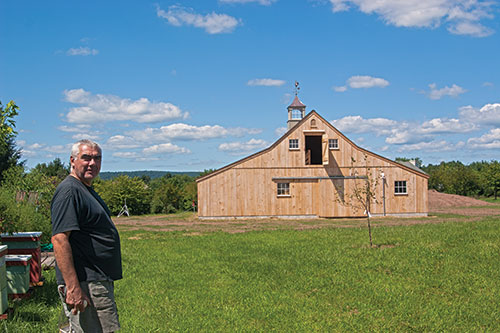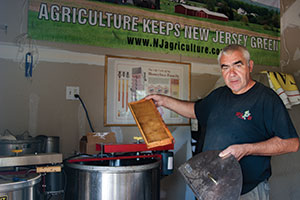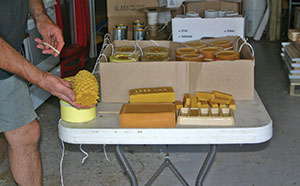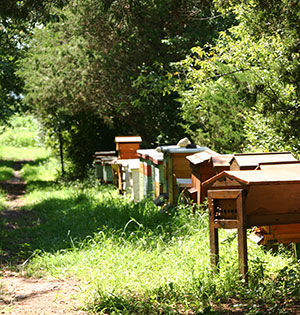Honeybees came to Jean-Claude Tassot by way of his great uncle, in the French countryside, when he was five years old. The boy helped, watched, and absorbed the subtleties of traditional techniques born from centuries of European beekeeping, until he moved to Paris years later. He grew up, got married, and came to America with his wife, Beatrice, when she got a transfer with Lucent Technologies in 1997. A few years later, Tassot built himself a hive in the backyard so he could teach his son what he knew about bees. The hive produced seventy-five pounds of honey, an amount so encouraging that Jean-Claude began to consider a family venture. More promising was the fact that hundred jars he supplied to a local farmstand sold out in ten days. Tassot Apiaries opened for business in 2002.

By the spring of 2013, Tassot tended over two-hundred hives with five different bee species producing ten tons of honey each year. The apiary is a “medium size” enterprise for New Jersey; some keep over a thousand hives. Most of the twenty-or-so locations where his hives reside trade the real estate for pollination services from Tassot bees. There are also hives at the Tassot’s Hunterdon County home in Milford, where they moved from Long Valley so they could have more space. Here, Jean Claude, Beatrice, their son, one helper and an occasional intern produce enough honey and related products to supply over fifty retail outlets year-round. The honey extractor is in the garage, as is the beeswax melter, where one Tassot or another pours wax into candle molds, centering each wick by hand. They also make lip balm, hand and body cream, soaps, furniture polish and blocks of wax for painting. But honey is what most people want.


Jean-Claude is a professional farmer. With his family, he makes his living from the honey he takes from his bees. So, while entirely involved with their health and welfare, he must be aggressive. Tassot feeds his bees early in the spring, stimulating the wintered hives to “get moving” sooner than they normally would. By early June, Tassot’s spring honey is ready with plenty of time left to generate another plentiful harvest by early fall. Hives are constructed in sections so that the bees’ essential business—that of the queen and her broods—can be conducted in the bottom two permanent boxes. The frames in the top layers of the hive hold comb filled with honey, transforming from flower nectar by a combination of duties by workers at different stages of their lives. The older foragers drink nectar from flowers, break down the complex sugars, and regurgitate the result back in the hive. Hive bees then ingest the modified nectar, further break down the sugars, then re-regurgitate the inverted nectar into honeycomb cells. Rapidly beating their wings, the hive bees fan the nectar to evaporate any remaining water and thicken the sugars into honey. When the it is ready, the hive bee caps the beeswax cell, sealing the honey into the honeycomb for later consumption. It takes twelve workers to make a teaspoon of honey; thousands to produce some two-hundred pounds in a typical colony each year. Out of that the beekeeper “steals” fifty to sixty percent of a hive’s annual output, leaving enough for the colony to sustain itself through the winter.


The apiary produces wild flower honey, of course, but also a dark, sweet honey from buckwheat and another from blueberries. They also churn honey into a spread spiced with cinnamon or Jalapeño peppers. This year the Tassot’s built a barn where they’ll have the room they need to make and store the apiary’s very popular merchandise. Not only will they be able to shop, visitors can watch the various processes involved, from honey extraction to bees wax production. Aspiring beekeepers will be able to purchase kits with which to assemble hives, and Jean-Claude will offer classes.
Tassot sighs when asked about the hard times wrought by Colony Collapse Disorder. During the winter of 2006-07, the apiary lost seventy percent of its hives. “Bees will not be healthy as long as we use pesticides. They lose their memories, can’t find their way home and are gone forever. But what can I do? We have to keep going.” Jean-Claude is an expert; he knows he has to work as hard as his bees.
In 2014, Jean-Claude and his team celebrated their 10th anniversary as your experts in beeswax candles, natural soaps and cosmetics, bee pollen, beekeeping equipment and of course…HONEY. Visit us at Buzzing Acres Farm! Tassot Apiaries, Buzzing Acres Farm, 54 Rick Rd., Milford, NJ• 908/264-4504